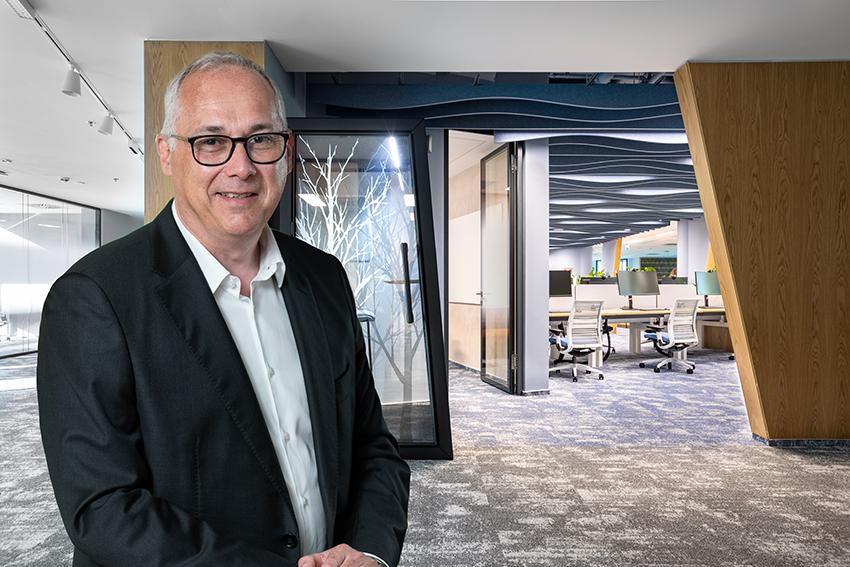2025-07-22
indicators

In a detailed conversation with CIJ EUROPE, Christophe Weller, CEO and Founder of COS Romania, explored how client expectations for office fit-outs have shifted in 2025. With hybrid work now firmly established as the norm, office design has entered a new era, one defined by flexibility, employee well-being, technology integration, and a deepening focus on sustainability. According to Weller, the hybrid workplace model has become the standard across industries. Companies are no longer experimenting with hybrid work—they are actively trying to define the right formula based on their operational needs. While some opt for full-time office presence, others are embracing a 50–70 percent hybrid ratio, calculated according to employee attendance patterns. The trend away from fully remote work is clear. Remote work may diminish, but hybrid, Weller says, “is here to stay.” This new model has prompted companies to rethink how much office space they really need. Rather than building offices for their full headcount, they now tailor workstations to expected attendance. Yet this downsizing hasn’t led to major cost savings. In fact, Weller notes that the cost per square metre has increased, as companies invest more in quality environments that make the office a desirable destination. The focus has shifted toward creating workplaces that employees enjoy using. As Weller explains, when people come to the office, they need to feel good, inspired, and supported. Many companies are responding by designing spaces that reflect elements of home—comfortable seating, informal lounges, welcoming cafeterias, and collaborative hubs that facilitate both planned and spontaneous interaction. These shifts are also influenced by the changing needs of younger generations, many of whom report feeling disconnected or unmotivated in traditional work environments. Technology has played a transformative role in this new office landscape. The pandemic made virtual meetings routine, and the tools needed to support these interactions—screens, microphones, Bluetooth devices, and video conferencing systems—are now standard in fit-out projects. Offices today are designed to support hybrid meetings at every level, ensuring seamless communication between on-site and remote participants. Furniture manufacturers are even integrating technology directly into their products to enhance functionality and improve the hybrid meeting experience. Sustainability has become another defining feature of the modern office. Weller points out that environmental responsibility is no longer a branding exercise; it is a real business and legal imperative. Companies are increasingly demanding carbon-neutral or even carbon-negative products, such as flooring made from recycled materials or reconditioned furniture. COS Romania has committed to this direction, working closely with suppliers who align with their sustainability objectives and improving their own certifications, including EcoVadis and ESG standards. This focus on responsibility extends beyond the environment to employee health. Weller describes how mental well-being has taken center stage. Burnout and stress are serious concerns, and companies are investing in features like quiet rooms, relaxation areas, wellness programs, and recreational zones to support mental health in the workplace. This is especially evident in service centres and call centres, where high-density environments require both functional noise reduction and spaces for employees to decompress. In terms of cost management, companies are adapting by reducing overall leased space while spending more on fit-out quality. Weller estimates that companies are now spending 15 to 20 percent more per square metre than before the pandemic, and sometimes even higher, due to advanced acoustic materials, privacy features, and upgraded technologies. Elements like sound-absorbing ceilings, privacy screens, and noise-dampening panels are becoming commonplace, aimed at creating a more comfortable and focused work environment. Reflecting on these developments, Weller draws a parallel to the social movements of the 1970s. He believes we are living through a kind of modern-day workplace revolution, driven by a desire for freedom, balance, and personal well-being. Today’s workforce wants flexibility, purpose, and spaces that support their whole lives—not just their job performance. There is a noticeable shift away from the single-minded career focus of past decades toward a more holistic view of work and life. Weller notes that this transformation brings both opportunity and uncertainty. Employers now face the challenge of motivating teams in an environment where traditional rules no longer apply. He describes how employers are trying to offer more freedom without losing productivity and cohesion. The pandemic, he says, forced people to reassess their priorities, and many have emerged with a stronger focus on family, health, and happiness. Offices must now support these values if they hope to attract and retain talent. As offices continue to evolve, Weller believes they will serve not just as places of work, but as tools for human connection, creativity, and well-being. While technology and efficiency are accelerating, companies are also striving to preserve the human element, encouraging collaboration and physical presence in a world that often leans toward digital detachment. Ultimately, Weller sees the role of the office as both practical and symbolic. It is a place where people come together, feel valued, and perform at their best. And while no one can predict the long-term impact of AI or further workplace revolutions, one thing is clear: the office of 2025 is more human, more thoughtful, and more responsive to the needs of its people than ever before. © 2025 www.cijeurope.com

